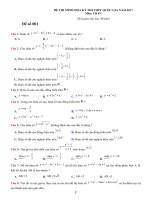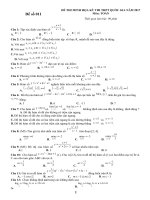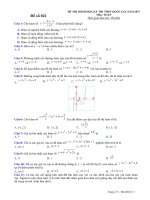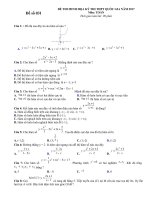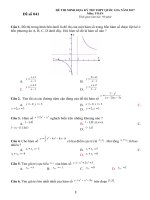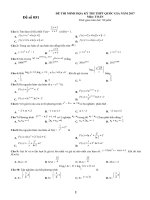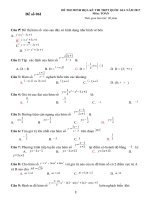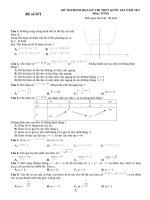Bo de file word co dap an chi tiet
Bạn đang xem bản rút gọn của tài liệu. Xem và tải ngay bản đầy đủ của tài liệu tại đây (377.81 KB, 10 trang )
ĐỀ THI THỬ TIẾNG ANH THPT QUỐC GIA 2017
Đ Ề SỐ 0
Thời gian làm bài: 60 phút
Mark the letter A, B, C, or D on your answer sheet to indicate the correct answer to each of the following questions
Question 1: “No students can get
with cheating in the exam.” the teacher said.
A. along
B. up
C. away
D. on
Question 2: He said he couldn’t give me a detailed description of the man because he had only
at him briefly.
A. gazed
B. stared
C. glanced
D. glared
Question 3: The children ran away as if they
a ghost.
A. saw
B. see
C. had seen
D. have seen
Question 4: We were so late that we
had time to catch the train.
A. hardly
B. nearly
C. almost
D. simply
Question 5: Frankly, I’d rather you
in that case.
A. not involved
B. were not involved
C. will not be involved
D. wouldn’t be involved
Question 6: Most of
archaeologists know about prehistoric cultures is based on studies of material
remains. A. the
B. what
C. which
D. those
Question 7: He was expecting a prison sentence but the judge took
on him.
A. disgrace
B. shame
C. dishonor
D. pity
Question 8: It is high time that measures
to prevent further traffic accidents.
A. are taken
B. were taken
C. should be taken
D. should have been taken
Question 9: Don’t drop litter wherever you want,
?
A. don’t you
B. won’t you
C. will you
D. do you
Question 10: We
the car for half a year before it was stolen.
A. had owned
B. have owned
C. were owning
D. owned
Question 11: The fire was caused by an
failure in the engine.
A. electrician
B. electricity
C. electric
D. electrical
Question 12: I would have paid
for my car if the salesman had insisted, because I really wanted it.
A. two times as much
B. much twice
C. twice as much
D. as much
twice
Mark the letter A, B, C, or D on your answer sheet to indicate the word that differs from the other three in the position
of the primary stress in each of the following questions.
Question 13: A. unselfish
B. acquaintance
C. humorous
D. attraction
Question 14: A. introduce
B. currency
C. marvelous
D. delegate
Mark the letter A, B, C, or D on your answer sheet to indicate the word whose underlined part differs from the
other three in pronunciation in each of the following questions.
Question 15: A. champagne
B. change
C. challenge
D. teacher
Question 16: A. introduction
B. question
C. production
D. expectation
Mark the letter A, B, C, or D on your answer sheet to indicate the word(s) CLOSEST in meaning to the underlined
word(s)
in each of the following questions.
Question 17: Because the jury had reached deadlock, the judge called for a retrial.
A. reduction
B. disagreement
C. impasse
D. verdict
Question 18: His tenacious personality made him top salesperson in the company.
A. explosive
B. charming
C. tenable
D. persistent
Mark the letter A, B, C, or D on your answer sheet to indicate the word(s) OPPOSITE in meaning to the
underlined word(s) in each of the following questions.
Question 19: Not only was John very obedient, but he rarely spoke out his own thoughts as well.
A. understanding
B. fresh
C. indiscreet
D. insubordinate
Page 1 |
8
Question 20: That was electrifying news to all of the company’s staff.
A. comforting
B. shocking
C. astounding
D. boring
Mark the letter A, B, C, or D on your answer sheet to indicate the underlined part that needs correction in each
of the following questions.
Question 21: It is recommended (A) that each person drinks (B) 2 liters of (C) water a (D) day.
Question 22: One of (A) the largest oceans (B) in the world (C) is Atlantic Ocean (D).
Question 23: Human body (A) does not stay at alike (B) temperature from (C) the morning till (D) the end of the day.
Mark the letter A, B, C or D on your answer sheet to indicate the most suitable response to complete each of
the following exchanges.
Question 24: Mason: "In my opinion, horror films are really exciting." - Lydia: "
_"
A. You shouldn’t have said that.
B. What an opinion!
C. There’s no doubt about that.
D. I don’t think so, either.
Question 25: Stephen: "It's been a difficult time, but I think everything is over now." - Sarah: "
"
A. I’m afraid not.
B. I hope so.
C. Good luck with that!
D. Yes, I can’t agree less.
Mark the letter A, B, C, or D on your answer sheet to indicate the sentence that best combines each pair of
sentences in the following questions.
Question 26: My father regrets taking up smoking. He can’t give it up now.
A. My father regrets having taken up smoking because he’s not able to give it up now.
B. My father wishes he hadn’t taken up smoking since he can’t cut down on it now.
C. My father can’t give up smoking now and feels regret about it.
D. Regretful as my father is, there might be a chance for him to stop smoking.
Question 27: Strip mining is one of the cheapest methods of mining. It is controversial because it harms the
environment. A. Strip mining, which is among the cheapest methods of mining, is controversial because it jeopardizes the
environment. B. Strip mining is one of the cheapest methods of mining, which is controversial because it does harm to
the environment. C. However harmful to the environment it is, strip mining is one of the cheapest methods of mining.
D. Strip mining is not the cheapest methods of mining, but it is controversial because it harms the environment.
Mark the letter A, B, C, or D on your answer sheet to indicate the sentence that is closest in meaning to each of
the following questions.
Question 28: Because they made too many mistakes, they failed in the exam.
A. They made very many mistakes that they failed in the exam.
B. They made too many mistakes that them to failed in the exam.
C. They made so many mistakes that they failed in the exam.
D. They made such many mistakes that they failed in the exam.
Question 29: No matter how hard I tried, I couldn’t open the door.
A. It was difficult for me to open the door.
B. I tried hard to open the door.
C. I could open the door easily.
D. Try as hard as I might, I couldn’t open the door.
Question 30: Flooding in this region was the result of heavy rain.
A. Heavy rain caused flooding in this region.
B. Flooding in this region was the cause of the heavy rain.
C. Heavy rain resulted from flooding in this region.
D. Because of flooding in this region, there was heavy rain.
Read the following passage and mark the letter A, B, C, or D on your answer sheet to indicate the correct word
or phrase that best fits each of the numbered blanks.
Comic Relief is a charitable organization based in London. It was set (31)
by comedians in 1985 in response to the
famine in Ethiopia, and uses comedy and laughter to get serious messages across. Since then over two thousand
celebrities have given their time and talent to Comic Relief, helping to raise 300 million to date.
Every two years, Comic relief organizes a nationwide fundraising event (32)
“Red Nose Day”. It is usually on a
Friday in March. On Red Nose Day, everyone in the country is encouraged to put a red nose and do something silly to
raise money for charity. In an event that unites the country, people from all walks of life do their bit for poor and underprivileged people in the UK and Africa.
In schools, uniforms are replaced by fancy dress, in offices across the nation, assistants (33)
over from their bosses
for the day. Every contribution is important, whether it is standing in the street collecting money from passers-by, or taking
(34)
in a sponsored event like sitting in a bathtub full of baked beans for twenty-four hours, or not talking for a(n)
whole day.
The event is televised in the evening, when the combination of comedy and hard-hitting documentaries persuades (35)
to make donations on their credit cards - over the phone or on the Internet - to those less fortunate than themselves.
Question 31: A. up
B. off
C. on
D. out
Question 32: A. described
B. called
C. known
D. named
Question 33: A. do
B. get
C. take
D. make
Question 34: A. involvement
B. part
C. participation
D. place
Question 35: A. viewers
B. observers
C. spectators
D. audience
Read the following passage and mark the letter A, B, C, or D on your answer sheet to indicate the correct word
or phrase that best fits each of the numbered blanks.
Traditionally in America, helping the poor was a matter for private charities or local governments. Arriving immigrants
depended mainly on predecessors from their homeland to help them start a new life. In the late 19th and early 20th
centuries, several European nations instituted public-welfare programs. But such a movement was slow to take hold in
the United States because the rapid pace of industrialization and the ready availability of farmland seemed to confirm the
belief that anyone who was willing to work could find a job.
Most of the programs started during the Depression era were temporary relief measures, but one of the programs Social
Security - has become an American institution. Paid for by deductions from the paychecks of working people, Social
Security ensures that retired persons receive a modest monthly income and also provides unemployment insurance,
disability insurance, and other assistance to those who need it. Social Security payments to retired persons can start at
age
62, but many wait until age 65, when the payments are slightly higher. Recently, there has been concern that the
Social Security fund may not have enough money to fulfill its obligations in the 21st century, when the population of
elderly Americans is expected to increase dramatically. Policy makers have proposed various ways to make up the
anticipated deficit, but a long-term solution is still being debated.
In the years since Roosevelt, other American presidents have established assistance programs. These include
Medicaid and Medicare; food stamps, certificates that people can use to purchase food; and public housing which is built
at federal expense and made available to persons on low incomes.
Needy Americans can also turn to sources other than the government for help. A broad spectrum of private charities and
voluntary organizations is available. Volunteerism is on the rise in the United States, especially among retired persons. It
is estimated that almost 50 percent of Americans over age 18 do volunteer work, and nearly 75 percent of U.S.
households contribute money to charity.
Question 36: It took welfare program a long time to gain a foodhold in the US due to the rapid growth of
_.
A. industrialization
B. population
C. urbanization
D. modernization
Question 37: The Social Security program has become possible thanks to
.
A. enforcement laws
B. deductions from wages
C. donations from companies
D. people's willingness to work
Question 38: Most of the public assistance programs
after the severe economic crisis.
A. were introduced into institutions
B. did not become institutionalized
C. functioned truthfully in institutions
D. did not work in institutions
Question 39: American on low incomes can seek help from
.
A. non-governmental agencies
B. governmental agencies
C. federal government
D. state government
Question 40: The word "instituted" in the first paragraph mostly means
_.
A. executed
B. introduced
C. studied
D. enforced
Question 41: That Social Security payments will be a burden comes from the concern that
. A. the program discourages working people
B. younger people don't want to work
C. elderly people ask for more money
D. the number of elderly people is growing
Question 42: New immigrants to America could seek help for
_.
A. only charity organizations
B. volunteer organizations
C. the people who came earlier
D. the US government organization
Read the following passage and mark the letter A, B, C, or D on your answer sheet to indicate the correct word or
phrase that best fits each of the numbered blanks.
According to the best evidence gathered by space probes and astronomers, Mars is an inhospitable planet, more similar
to Earth’s Moon than to Earth itself - a dry, stark, seemingly lifeless world. Mars’ air pressure is equal to Earth’s at an
altitude of 100,000 feet. The air there is 95 percent carbon dioxide.
Mars has no ozone layer to screen out the sun’s lethal radiation. Daytime temperatures may reach above freezing, but
because the planet is blanketed by the mere wisp of an atmosphere, the heat radiates back into space. Even at the equator,
the temperature drops to -50C (-60F) at night. Today there is no liquid water, although valleys and channels on the surface
show evidence of having been carved by running water. The polar ice caps are made of frozen water and carbon dioxide,
and water may be frozen in the ground as permafrost.
Despite these difficult conditions, certain scientists believe that there is a possibility of transforming Mars into a more
Earth-like planet. Nuclear reactors might be used to melt frozen gases and eventually build up the atmosphere. This in turn
could create a “greenhouse effect” that would stop heat from radiating back into space. Liquid water could be thawed to
from a polar ocean. Once enough ice has melted, suitable plants could be introduced to build up the level of oxygen in the
atmosphere so that, in time, the planet would support animal life from Earth and even permanent human colonies. “This was
once thought to be so far in the future as to be irrelevant,” said Christopher McKay, a research scientist at NASA. “But now
it’s starting to look practical. We could begin work in four or five decades.”
The idea of “terraforming” Mars, as enthusiasts call it, has its roots in science fiction. But as researchers develop a more
profound understanding of how Earth's ecology supports life, they have begun to see how it may be possible to create
similar conditions on Mars. Don’t plan on homesteading on Mars any time soon, though. The process could take hundreds
or even thousands of years to complete and the cost would be staggering.
Question 43: The word "there" in bold in paragraph 1 refers to
_.
A. the Earth's Moon
B. Mars
C. outer space
D. a point 100 miles above the Earth
Question 44: Which of the following does the author NOT list as a characteristic of the planet Mars that would make
colonization difficult?
A. There is little liquid water.
B. The sun's rays are deadly.
C. Daytime temperatures are dangerously high.
D. Night time temperatures are extremely low.
Question 45: It can be inferred from the passage that the "greenhouse effect" mention in paragraph 3 is
.
A. the direct result of nuclear reactions
B. the cause of low temperatures on Mars
C. caused by the introduction of green plants
D. a possible means of warming Mars
Question 46: According to Christopher McKay, the possibility of transforming Mars
_.
A. could only occur in science fiction stories
B. will not begin for hundreds, even thousands of years
C. is completely impractical
D. could be started in forty to fifty years
Question 47: According to the article, the basic knowledge needed to transform Mars comes from
.
A. the science of astronomy
B. data from space probes
C. a knowledge of Earth's ecology
D. science fiction stories
Question 48: According to the passage, the Martian atmosphere today consists mainly of
_.
A. oxygen
B. carbon dioxide
C. ozone
D. water vapor
Question 49: The word "inhospitable" in bold in paragraph 1 is closest in meaning to
_.
A. generous
B. uninhabitable
C. hostile
D. green
Question 50: What is the main idea of the passage?
A. The possibility of changing the Martian environment
B. The challenge of interplanetary travel
C. The need to study the Martian ecology
D. The advantages of establishing colonies on Mars
ĐÁP ÁN ĐỀ THI THỬ TIẾNG ANH SỐ 1
Câu
Đáp án
Câu
Đáp án
Câu
Đáp án
Câu
Đáp án
Câu
Đáp án
1
2
3
4
5
6
7
8
9
10
C
C
C
A
B
B
D
B
C
A
11
12
13
14
15
16
17
18
19
20
D
C
C
A
A
B
C
D
D
D
21
22
23
24
25
26
27
28
29
30
B
D
B
C
B
A
A
C
D
A
31
32
33
34
35
36
37
38
39
40
A
B
C
B
A
A
B
B
A
B
41
42
43
44
45
46
47
48
49
50
D
C
B
C
D
D
C
B
B
A
Question 1: Đáp án C.
Cụm động từ “get away with + doing something” có nghĩa là làm gì đó xấu mà không bị phạt (trốn được
tội).
Ngoài ra có thể học thêm các cụm khác:
get along with somebody: hòa hợp với ai đó (= get on (well) with somebody).
get on: lên xe, lên tàu/ tiếp tục.
get up: đứng dậy/ trở nên mạnh hơn (gió).
Question 2: Đáp án C.
Cụm “glance at” có nghĩa là “nhìn liếc qua, nhìn thoáng qua”.
Ngoài ra có thể học thêm các cụm khác:
gaze at: nhìn chằm chằm.
stare at: nhìn chằm chằm (= gaze at).
glare at: nhìn trừng trừng, nhìn giận dữ.
Question 3: Đáp án C.
Cụm “as if” có nghĩa là “như thể là”.
Khi dùng “as if” thì mệnh đề sau nó thường phải lùi 1 thì so với thì chính ở trong câu.
Question 4: Đáp án A.
“hardly” có nghĩa là “gần như không” (mang nghĩa phủ định).
“We were so late that we hardly had time to catch the train.”: Chúng tôi bị muộn tới mức mà gần như không có
thời gian bắt kịp chuyến tàu hỏa.
Question 5: Đáp án B.
Cấu trúc “S1 + would rather + S2 + V(chia ở quá khứ)”: Ai đó muốn ai làm gì.
“Frankly, I’d rather you were not involved in that case.”: Thành thật thì tôi không muốn cậu dính líu vào vụ đó.
Question 6: Đáp án B.
Ở đây “what archaeologists know about prehistoric cultures” có thể coi là một cụm danh từ (trong trường hợp
này “what” là một đại từ quan hệ và nó viết tắt thay thế cho cụm “the things that”).
Question 7: Đáp án D.
Cụm “take pity on someone” có nghĩa là “thông cảm, tội nghiệp cho ai đó”.
Question 8: Đáp án B.
Cấu trúc “It is + (high) time + (that) S + V(chia ở quá khứ)”: Đã đến lúc ai đó/ cái gì đó làm gì.
Ngoài ra còn có cấu trúc mang ý nghĩa tương tự là: “It is + (high) time + for + S + to V(nguyên thể)”.
Question 9: Đáp án C.
Đây là dạng bài tập Câu hỏi đuôi (Tag Questions). Đối với câu dạng mệnh lệnh thì phần câu hỏi đuôi bao
giờ cũng là “will you?”.
Question 10: Đáp án A.
Vì hành động “sở hữu” diễn ra trước và kết thúc khi hành động “bị đánh cắp” xảy ra nên phải dùng thì quá
khứ hoàn thành để diễn tả một hành động diễn ra trươc 1 hành động khác trong quá khứ.
Question 11: Đáp án D.
Khi sử dụng nghĩa “chập điện” thì phải dùng cụm “electrical failure”.
Question 12: Đáp án C.
Cụm “twice as much” có nghĩa là “gấp đôi” (gấp đôi 1 lượng nào đó, do đã biết lượng này trong ngữ cảnh của câu
nên không cần nhắc lại).
Question 13: Đáp án C.
Từ “humorous” có trọng âm rơi vào âm tiết thứ nhất, trong khi các từ còn lại có trọng âm rơi vào âm tiết thứ 2.
Question 14: Đáp án A.
Từ “introduce” có trọng âm rơi vào âm tiết thứ ba, trong khi các từ còn lại có trọng âm rơi vào âm tiết thứ nhất.
Question 15: Đáp án A.
“ch” của từ “champagne” được phát âm là /ʃ/, trong khi “ch” của các từ còn lại phất âm là /tʃ/.
Question 16: Đáp án A.
“tion” của từ “question” được phát âm là /tʃən/, trong khi “tion” của các từ còn lại phất âm là /ʃən/.
Question 17: Đáp án C.
deadlock (n): sự bế tắc, ngõ cụt, không có cách giải quyết = impasse (n): ngõ cụt, thế bế
tắc.
Ngoài ra có thể học thêm nghĩa của các từ khác:
reduction (n): sự giảm thiểu, sự thu nhỏ, sự giảm bớt.
verdict (n): lời tuyên án, lời phán quyết/ dư luận.
Question 18: Đáp án D.
tenacious (adj): bên bì, kiên trì, ngoan cường ~ persistent (adj): kiên trì, bền bì/ dai
dẳng.
Ngoài ra có thể học thêm nghĩa của các từ khác:
explosive (adj): dễ nổ, gây nổ; explosive (n): chất nổ.
charming (adj): quyến rũ, làm say mê.
tenable (adj): bảo vệ được, giữ được, cố thủ được.
Question 19: Đáp án D.
obedient (adj): vâng lời, dễ bảo, ngoan ngoãn >< insubordinate (adj): không chịu vâng lời, không chịu phục
tùng.
Ngoài ra có thể học thêm nghĩa của các từ khác:
understanding (adj): nhân ái, vị tha, biết thông cảm; understanding (n): hiểu biết.
fresh (adj): tươi, mơn mởn/ tươi mát, trong sạch, mát mẻ.
indiscreet (adj): vô ý, không thận trọng.
Question 20: Đáp án D.
electrifying (adj) (= very exciting): rất thú vị >< boring (adj): chán, nhạt nhẽo, vô
vị.
Ngoài ra có thể học thêm nghĩa của các từ khác:
comforting (adj): làm xoa dịu (nỗi buồn, sự lo lắng…).
shocking (adj): gây bất ngờ, gây ngạc nhiên, gây sốc (= astounding).
Question 21: Đáp án B.
Sửa: “drinks” ð “drink”. Đây là dạng ngữ pháp về Thể giả định (Subjunctive). Trong thể giả định thì động từ
của mệnh đề sau “that” phải ở dạng nguyên thể hoặc là “should + V(nguyên thể)”.
Từ “recommended” trong câu này chính là từ quyết định đây là thể giả định. Một vài các tính từ khác tương tự là
“essential”, “necessary”, “important”, “advisable”, “compulsory”…
Question 22: Đáp án D.
Sửa: “Atlantic Ocean” ð “the Atlantic Ocean”. Lưu ý rằng Biển Đại Tây Dương thì phải có “the” đi kèm.
Question 23: Đáp án B.
Sửa: “at alike” ð “at the same”. Ở đây cụm “stay at the same temperature” có nghĩa là “giữ nguyên nhiệt độ/
thân nhiệt”.
Question 24: Đáp án C.
Mason: “Theo tớ, phim kinh dị thật sự rất thú vị.” - Lydia: “Không có nghi vấn gì về việc đó cả.”
Question 25: Đáp án B.
Stephen: “Thời gian qua quả là khó khăn, nhưng tôi nghĩ mọi chuyện đã qua rồi.” - Sarah: “Hi vọng là như vậy.”
Question 26: Đáp án A.
Lưu ý rằng “regret having done something” = “regret doing something” đều có nghĩa là “hối hận vì đã làm gì”.
Cụm động từ “cut down on something” có nghĩa là “giảm bớt” (không có nghĩa là “bỏ hẳn”).
Question 27: Đáp án A.
jeopardize (v): gây nguy hại, gây nguy hiểm (~ harm).
Lưu ý rằng “one of the cheapest methods of mining” = “among the cheapest methods of mining”.
Question 28: Đáp án C.
Dịch câu gốc: Vì chúng mắc lắm lỗi quá nên trượt bài kiểm tra.
Lưu ý cấu trúc “… so ... that …” có nghĩa là “… quá … đến nỗi …”. Cả 3 đáp án còn lại đều sử dụng sai cấu
trúc vừa xong.
Question 29: Đáp án D.
Dịch câu gốc: Dù cố bao nhiêu tôi vẫn không mở được cửa.
Lưu ý cấu trúc “No matter how hard + S + try” = “Try + as hard as + S might” (dạng đảo ngữ): Dù cố gắng
lắm rồi, dù có cố gắng thế nào.
Question 30: Đáp án A.
Dịch câu gốc: Tình trạng ngập lụt ở vùng này là kết quả của mưa nặng hạt.
Lưu ý rằng “result from something” có nghĩa là “là hệ quả của cái gì”; còn “result in something” =
“cause something” có nghĩa là “gây ra cái gì”.
Question 31: Đáp án A.
set up: thành lập, thiết lập cái gì.
Ngoài ra có thể học thêm nghĩa của các cụm khác:
set off: khởi hành (bắt đầu 1 chuyến đi).
set on/upon: tấn công/ bao vây.
set out: làm việc với một nỗ lực nghiêm chỉnh, có mục đích rõ rang/ bắt đầu 1 chuyến đi.
Question 32: Đáp án B.
Cụm “be called + something” có nghĩa là “được gọi là gì”.
Ngoài ra có thể học thêm nghĩa của các cụm khác:
be described as something: được mô tả như là.
be known as something: được biết đến như là.
be named + something: được đặt tên là.
Question 33: Đáp án C.
take over from somebody: đảm nhiệm vị trí của ai đó, thế chỗ ai đó.
Ngoài ra có thể học thêm nghĩa của các cụm khác:
get over: chấp nhận sự thật/ vượt qua (bệnh tật, khó khăn…).
make over: tu sửa, chỉnh trang.
do over: tấn công một cách dữ dội.
Question 34: Đáp án B.
take part in something (= participate in something): tham gia vào cái gì.
Question 35: Đáp án A.
Vì ở đây có nhắc đến TV ("televised") nên phải dùng "viewer" (người xem TV thì chỉ có thể dùng từ
"viewer")
Ngoài ra có thể học cách sử dụng của các từ chỉ người xem khác:
observer (n): người xem chung chung (mà không tham gia vào).
audience (n): khán giả, người xem trong các buổi biểu diễn, buổi hòa nhạc…
spectator (n): khán giả, người xem trong các sự kiện đại chúng, đặc biệt là xem 1 trận, sự kiện thể thao.
Question 36: Đáp án A.
Thông tin nằm ở cuối đoạn 1: "But such a movement was slow to take hold in the United States because the
rapid pace of industrialization ...".
Question 37: Đáp án B.
Dẫn chứng bắt đầu từ câu thứ 2 đoạn 2: "Paid for by deductions from the paychecks of working people, Social
Security ensures that retired persons receive a modest monthly income and also provides unemployment
insurance, disability insurance, and other assistance to those who need it". Lưu ý: "paycheck" là tấm séc lương
(1 hình thức trả lương); "deduction" là khoản tiền khấu trừ, trích ra.
Question 38: Đáp án B.
Câu trả lời nằm ở câu đầu đoạn 2: "Most of the programs started during the Depression era were temporary relief
measures, but one of the programs - Social Security - has become an American institution". Lưu ý: relief
measures: các biện pháp cứu trợ tạm thời; become institutionalized: được thể chế hóa (lâu dài và chính thức).
Question 39: Đáp án A.
Câu trả lời được suy ra từ đoạn cuối: "Needy Americans can also turn to sources other than the government for
help. A broad spectrum of private charities and voluntary organizations is available". Lưu ý: "other than" =
"instead of" nghĩa là "thay vì".
Question 40: Đáp án B.
institute (v): thành lập, lập nên/ tiến hành ~ introduce (v): giới thiệu/ đưa ra áp dụng; execute (v): thực hiện, thi
hành (một chương trình lập trình trong máy tính)/ hành hình; enforce (v): làm cho có hiệu lực/ thúc ép.
Question 41: Đáp án D.
Thông tin rất rõ ràng ở trong câu sau ở gần cuối đoạn 2, chỉ là viết lại theo cách khác: "Recently, there has been
concern that the Social Security fund may not have enough money to fulfill its obligations in the 21st century,
when the population of elderly Americans is expected to increase dramatically ".
Question 42: Đáp án C.
Dẫn chứng ở câu 2 đoạn 1: "Arriving immigrants depended mainly on predecessors from their homeland to
help them start a new life" (predecessor (n): người tiền nhiệm, tiền bối).
Question 43: Đáp án B.
Dẫn chứng: "Mars’ air pressure is equal to Earth’s at an altitude of 100,000 feet. The air there is 95 percent
carbon dioxide".
Question 44: Đáp án C.
Dẫn chứng ở đoạn 2: "Daytime temperatures may reach above freezing, but because the planet is blanketed by
the mere wisp of an atmosphere, the heat radiates back into space. Even at the equator, the temperature drops to
-50C (-60F) at night". Như vậy nhiệt độ ban ngày không phải là cao đến mức nguy hiểm mà chỉ có thể đạt được
trên
mức đông lạnh thôi.
Ngoài ra, có thể dễ dàng thấy các đáp án còn lại đã được nhắc đến.
Question 45: Đáp án D.
Câu hỏi này cần phải suy luận một chút:
"This in turn could create a “greenhouse effect” that would stop heat from radiating back into space".
Đọc lại chỗ này ở đoạn 2: "Daytime temperatures may reach above freezing, but because the planet is
blanketed by the mere wisp of an atmosphere, the heat radiates back into space".
ð Có thể thấy 1 nguyên nhân khiến cho nhiệt độ thấp là do "the heat radiates back into space". Trong khi đó
"greenhouse effect" thì lại "stop the heat from radiating back into space", tức là nó sẽ có thể khiến nhiệt độ
ấm lên.
Question 46: Đáp án D.
Dẫn chứng ở cuối đoạn 3: "We could begin work in four or five decades ".
Question 47: Đáp án C.
Dẫn chứng ở đoạn cuối: "But as researchers develop a more profound understanding of how Earth's
ecology supports life, they have begun to see how it may be possible to create similar conditions on Mars".
Question 48: Đáp án B.
Dẫn chứng ở câu cuối đoạn 1: "The air there is 95 percent carbon dioxide".
Question 49: Đáp án B.
Trong ngữ cảnh này thì: inhospitable (adj): không ở được, không trú ngụ được (do khí hậu, môi trường...) ~
uninhabitable (adj): không ở được, không cư trú được.
Question 50: Đáp án A.
Sau khi đọc hiểu thì có thể thấy ý chính của bài đọc này là "Khả năg thay đổi môi trường trên sao Hỏa".
BÁN BỘ ĐỀ LUYỆN THPTQG ĐÁP ÁN CHI TIẾT
BỘ ĐỀ: GIÁ 50.000/ 35 đề file word, đề mỗi 1 file riêng (file word có thể chỉnh sửa nhé), file đáp án riêng, đề thi theo cấu trúc
đề minh họa 2017 có format là 50 câu trắc nghiệm như sau:
2 câu phát âm, 2 câu stress, 3 câu tìm lỗi sai, 12 câu ngữ pháp, 2 câu giao tiếp, 2 câu chọn từ bằng nghĩa, 2 câu chọn từ trái
ngĩa, 3 câu viết lại câu bằng nghĩa, 2 câu dạng nối câu, đoạn văn điền từ 5 câu, 2 đoạn đọc hiểu, 1 đoạn 7 câu, 1 đoạn 8 câu.
Nếu các bạn mua 28 đề này, mình gửi tặng kèm trọn bộ tài liệu cũ của năm ngoái, tất cả đều có đáp án chi tiết từng câu nhé,
chỉ bất tiện là tài cũ theo cấu trúc đề cũ, các bạn phải format lại nhé.
Ngoài ra mình còn bán BỘ LUYỆN NGHE NÂNG CAO (do người nước ngoài đọc) lớp 10-11-12 giá 50.000: Mỗi lớp gồm 16
file MP3 dựa theo các chủ đề trong SGK và 1 file word tapescript cùng bài tập bên mình tự soạn, (nếu thầy cô nào không
thích có thể tự soạn bài tập khác dựa vào tapesript). Mua bộ luyện nghe tặng kèm file sách Ngữ Pháp Mai Lan Hương.
Và 2 file sách cực chất trong phần luyện thi 2 dạng bài khó nhất của kì thi THPTQG
1
Sách luyện đọc hiểu dày hơn 300 trang A4 (file pdf) với đáp án chi tiết cho từng câu: giá chỉ 50.000
2
Sách luyện bài tập điền từ vào đoạn văn (file pdf), dày hơn 300 trang A4, có giải thích đáp án chi tiết cho từng câu
và dịch cả đoạn văn , giá chỉ 50.000
(mua 2 file sách này sẽ được tặng trọn bộ tài liệu ôn thi THPTQG của năm 2016 nhé)
3
4
5
sách BÀI TẬP TIẾNG ANH LỚP 6,7,8,10 theo chương trình thí điểm của
Pearson của tác giả Lưu Hoằng Trí.
sách BÀI TẬP TIẾNG ANH LỚP 11 theo chương trình thí điểm của Pearson của
tác giả Lưu Hoằng Trí.
Mỗi quyển mình bán giá 50.000 (tặng kèm file đáp án, file đáp án nằm riêng
nha các bạn)
(Tất cả phần tài liệu trên đây được chuyển qua email của các bạn sau khi các bạn đã thanh toán cho bên mình)
Bộ tài liệu ôn thi vào lớp 10 giá 50.000 gổm: Bộ đề file word, hơn 30 đề, có đáp án và sách BỘ ĐỀ ÔN THI VÀO
LỚP 10 của tác giả Lưu Hoằng Trí (gồm hơn 40 đề, có đáp án)
Cách thanh toán:
1/ Các bạn thanh toán trước qua chuyển khoản sau đó nhắn tin hoặc email
cho mình biết địa chỉ email, mình sẽ gửi tài liệu ngay sau khi nhận thanh toán.
Tài khoản 1: 2214 20508 1225 Tên Cấn Hữu Biên,
chi nhánh ngân hàng Argibank Thạch Thất-Hà Nội
Tài khoản 2: 0081 0006 15400 , Tên LÊ THỊ LÝ,
Vietcombank chi nhánh Bà Rịa.
2/ Thanh toán qua thẻ cào điện thoại:
For ex: Mua bộ đề thi thử THPTQG, thẻ Viettel mệnh giá 50.000
mã số thẻ: 2354 57868 5968
Số serial: 49056 607840898
P/S: bạn nào không biết cách snapshot bài tập cần chọn ở file PDF để paste
sang file Word thì mình sẽ gửi Video hướng dẫn nhé.
Email:
Facebook: />Bạn nào dùng facebook thì add friend mình nhé, mình thường xuyên đăng
những tài liệu download free trên facebook.
Phone: 01647 057 038
Dưới đây là đề mẫu, tất cả các đề mình cam đoan là giải chi tiết như thế này hoặc chi tiết hơn chứ ko hề sơ sài
nhé (vui lòng đừng copy đề của mình rồi đem bán trên các trang khác nhé ^ ^)Và các bạn phải thanh toán trước
giúp mình nhé, nếu các bạn không tin tưởng thì mình sẽ cho link 123.doc.org để các bạn tải về, nhưng khi nạp
card vào tài khoản trang này thì các bạn phải mất chiết khấu phần trăm, và mình cũng mất chiết khấu %


